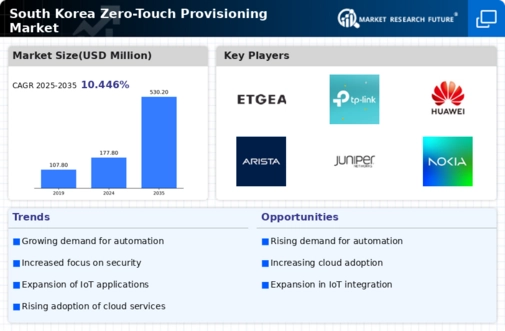Emergence of 5G Technology
The emergence of 5G technology is poised to have a transformative impact on the zero touch-provisioning market in South Korea. With the rollout of 5G networks, there is an increasing demand for efficient provisioning methods that can support the high-speed and low-latency requirements of next-generation applications. Zero touch-provisioning solutions are well-suited to meet these demands, enabling rapid deployment and management of devices in a 5G environment. As 5G adoption accelerates, it is expected that the zero touch-provisioning market will witness a growth rate of approximately 40% by 2026. This trend underscores the critical role that zero touch-provisioning will play in facilitating the seamless integration of 5G technology into various sectors, including telecommunications, healthcare, and smart cities.
Increased Focus on Cybersecurity
In the context of the zero touch-provisioning market, the heightened focus on cybersecurity in South Korea plays a pivotal role. As cyber threats become more sophisticated, organizations are compelled to adopt secure provisioning methods that minimize vulnerabilities. Zero touch-provisioning solutions offer enhanced security features, such as automated updates and configuration management, which are essential for protecting sensitive data. In 2025, it is anticipated that cybersecurity investments in South Korea will exceed $5 billion, further emphasizing the importance of secure provisioning methods. This increased focus on cybersecurity is likely to drive the adoption of zero touch-provisioning solutions, as businesses seek to safeguard their networks while maintaining operational efficiency.
Advancements in Cloud Technologies
The zero touch-provisioning market is significantly influenced by advancements in cloud technologies within South Korea. As organizations migrate to cloud-based infrastructures, the need for automated provisioning solutions becomes increasingly critical. The integration of zero touch-provisioning with cloud services allows for rapid deployment and management of network devices, reducing the time and effort required for manual configurations. In 2025, the cloud services market in South Korea is projected to reach $10 billion, with a substantial portion attributed to zero touch-provisioning solutions. This synergy between cloud technologies and zero touch-provisioning is expected to drive innovation and efficiency, positioning the market for substantial growth in the coming years.
Growing Demand for Seamless Connectivity
The zero touch-provisioning market in South Korea is experiencing a surge in demand for seamless connectivity solutions. As businesses increasingly rely on uninterrupted network access, the need for efficient provisioning methods becomes paramount. This trend is driven by the proliferation of remote work and the necessity for reliable communication channels. In 2025, it is estimated that the demand for seamless connectivity solutions will grow by approximately 30%, indicating a robust market potential. Companies are seeking zero touch-provisioning solutions to streamline their network management processes, thereby enhancing operational efficiency. This growing demand is likely to propel the zero touch-provisioning market forward, as organizations prioritize solutions that minimize downtime and optimize resource allocation.
Rising Need for Cost-Effective Solutions
The zero touch-provisioning market is also being driven by the rising need for cost-effective solutions among South Korean enterprises. As organizations strive to optimize their operational expenditures, zero touch-provisioning offers a compelling value proposition by reducing the costs associated with manual provisioning processes. By automating device configurations and updates, businesses can significantly lower labor costs and minimize errors. In 2025, it is projected that the adoption of cost-effective provisioning solutions will increase by 25%, as companies seek to enhance their bottom line. This trend indicates a growing recognition of the financial benefits associated with zero touch-provisioning, positioning it as a preferred choice for organizations aiming to streamline their operations.


















Leave a Comment